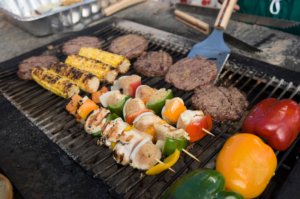Summer Grilling Has Begun
go.ncsu.edu/readext?867257
en Español / em Português
El inglés es el idioma de control de esta página. En la medida en que haya algún conflicto entre la traducción al inglés y la traducción, el inglés prevalece.
Al hacer clic en el enlace de traducción se activa un servicio de traducción gratuito para convertir la página al español. Al igual que con cualquier traducción por Internet, la conversión no es sensible al contexto y puede que no traduzca el texto en su significado original. NC State Extension no garantiza la exactitud del texto traducido. Por favor, tenga en cuenta que algunas aplicaciones y/o servicios pueden no funcionar como se espera cuando se traducen.
Português
Inglês é o idioma de controle desta página. Na medida que haja algum conflito entre o texto original em Inglês e a tradução, o Inglês prevalece.
Ao clicar no link de tradução, um serviço gratuito de tradução será ativado para converter a página para o Português. Como em qualquer tradução pela internet, a conversão não é sensivel ao contexto e pode não ocorrer a tradução para o significado orginal. O serviço de Extensão da Carolina do Norte (NC State Extension) não garante a exatidão do texto traduzido. Por favor, observe que algumas funções ou serviços podem não funcionar como esperado após a tradução.
English
English is the controlling language of this page. To the extent there is any conflict between the English text and the translation, English controls.
Clicking on the translation link activates a free translation service to convert the page to Spanish. As with any Internet translation, the conversion is not context-sensitive and may not translate the text to its original meaning. NC State Extension does not guarantee the accuracy of the translated text. Please note that some applications and/or services may not function as expected when translated.
Collapse ▲ Memorial Day usually starts the summer get-togethers. Many of us like using our grills in the summer months. Here are some tips to keep in mind, so that we end up serving safe foods as well as tasty foods.
Memorial Day usually starts the summer get-togethers. Many of us like using our grills in the summer months. Here are some tips to keep in mind, so that we end up serving safe foods as well as tasty foods.
One important lesson for all grillers is to remember that color is never a reliable indicator of safety and doneness. Use a food thermometer to ensure the following safe internal temperatures:
- Cook poultry (whole or ground) to 165 F.
- Cook beef, pork, lamb and veal steaks, chops and roasts to 145 F. For safety and quality, allow the meat to rest for at least three minutes before carving or consuming.
- Cook ground beef, pork, lamb and veal to 160 F.
- Cook egg dishes to 160 F.
- Cook fish to 145 F.
- Don’t have a food thermometer? Call the USDA Meat and Poultry Hotline at 1-888-MPHotline (1-888-674-6854).
Although frozen products may appear to be pre-cooked or browned, they should be handled and prepared no differently than raw products and must be grilled to appropriate temperatures. Frozen products may be labeled with phrases such as “Cook and Serve,” “Ready to Cook” and “Oven Ready” to indicate they must be cooked.
Plan ahead to give yourself plenty of time to thoroughly cook your meats. If mixing meat and vegetables such as grilling skewers the meat still needs to get to the safe internal temperature to ensure that it is safe to eat. Throw out any used marinade and clean any plates and utensils that were used on uncooked meats, seafood and fish. This can prevent any accidental cross-contamination with your final cooked foods.
Lastly, make sure to keep cooked foods hot (above 135 degrees) and cold foods cold (below 41 degrees) as you wait to eat or are waiting to store leftovers. In the summer months, foods should only be left out for one hour before being stored safely in refrigerators or coolers.
If you have food safety questions, or other food-related questions please call our office or email cathy_hohenstein@ncsu.edu for help.




